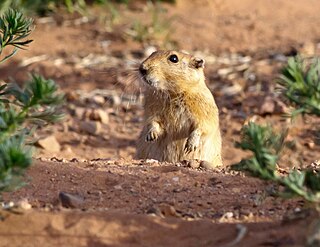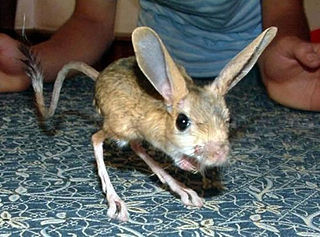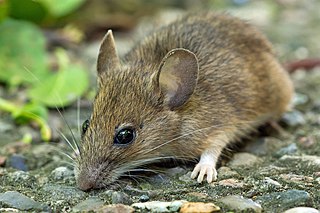 W
WThe Asian garden dormouse or large-eared garden dormouse, is a species of rodent in the family Gliridae. It is found in Egypt, Iraq, Israel, Jordan, Lebanon, Libya, Saudi Arabia, Syria and Turkey. Its natural habitats are temperate forests, subtropical or tropical dry shrubland, Mediterranean-type shrubby vegetation, rocky areas and gardens. It is active throughout the year but can enter a state of torpor. Diet consists mainly of insects, snails, centipedes and geckos but as an omnivore, it will also eat plant matter. It is a common species and the International Union for Conservation of Nature has assessed its conservation status as being of "least concern".
 W
WThe Barbary striped grass mouse is a small rodent of the suborder Myomorpha. This monotypic species is native to coastal Morocco, Algeria and Tunisia in northwest Africa. In the past it was believed to also occur throughout a large part of Sub-Saharan Africa, but these populations are now treated as a separate species, the Heuglin's striped grass mouse. These relatively small Lemniscomys are among the species most commonly kept in captivity.
 W
WThe Cairo spiny mouse, also known as the common spiny mouse, Egyptian spiny mouse, or Arabian spiny mouse, is a nocturnal species of rodent in the family Muridae. It is found in Africa north of the Sahara, where its natural habitats are rocky areas and hot deserts. It is omnivorous and feeds on seeds, desert plants, snails, and insects. It is a gregarious animal and lives in small family groups.
 W
WThe fat sand rat is a terrestrial mammal from the gerbil subfamily that is mostly found in North Africa and the Middle East, ranging from Mauritania to the Arabian Peninsula. This species usually lives in sandy deserts, but may also be found in rocky terrain or saline marsh areas. Fat sand rats are very selective in their diet, only eating stems and leaves of plants from the family Amaranthaceae, more commonly known as the amaranth family. In captivity, fat sand rats can become obese and rapidly develop diabetes-like symptoms when fed the diet typically given to other rodents. P. obesus has an average lifespan of 14 months in the wild and 3–4 years in captivity.
 W
WThe four-toed jerboa is a rodent of the family Dipodidae and genus Allactaga that has four digits. It is the sole species in the subgenus Scarturus. Four-toed jerboas are native to Egypt and Libya. They live in coastal salt marshes and dry deserts.
 W
WThe fat-tailed gerbil, also called the duprasi gerbil, is a rodent belonging to subfamily Gerbillinae. It is the only member of the genus Pachyuromys. These rodents are the most docile species of the Gerbil subfamily. They have fluffy and soft fur. Fat-tailed gerbils have been available on the pet market for decades, but in the 21st century breeders can be hard to find. They are sometimes considered as pocket pets.
 W
WThe greater Egyptian gerbil is a small rodent in the family Muridae. It is native to northern Africa where it inhabits sandy deserts, semi-arid areas and oases. It is a common species, and the International Union for Conservation of Nature has rated its conservation status as being of "least concern".
 W
WThe greater Egyptian jerboa is a species of rodent in the family Dipodidae. It is found in Algeria, Egypt, Libya, Morocco, Saudi Arabia, Tunisia, and is possibly extinct in the Negev Desert of Israel. Its natural habitats are subtropical or tropical dry shrubland, sandy shores, and arable land.
 W
WThe lesser jerboa is a small rodent of Africa and the Middle East. Its diet consists mainly of seeds and grasses, however the Jerboa needs very little water to survive.
 W
WThe North African gerbil is a species of rodent in the family Muridae. It is found in North Africa where its natural habitats are arable land and rocky areas of the Maghreb, and hot Saharan deserts.
 W
WThe pale gerbil (Gerbillus perpallidus) is endemic to Egypt and is distributed mainly in the northwestern part of the country. It is also known as the pallid gerbil. The pale gerbil has pale orange fur, with white underparts, white forelimbs and white feet. The ears are unpigmented and the soles of the feet are haired, which is a characteristic of sand-dwelling gerbils.
 W
WThe wood mouse is a murid rodent native to Europe and northwestern Africa. It is closely related to the yellow-necked mouse but differs in that it has no band of yellow fur around the neck, has slightly smaller ears, and is usually slightly smaller overall: around 90 mm (3.54 in) in length and 23 g in weight. It is found across most of Europe and is a very common and widespread species, is commensal with people and is sometimes considered a pest. Other common names are long-tailed field mouse, field mouse, common field mouse, and European wood mouse.